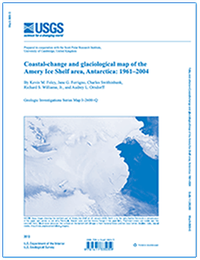Reduction in the area and volume of Earth’s two polar ice sheets is intricately linked to changes in global climate and to the resulting rise in sea level. Measurement of changes in area and mass balance of the Antarctic ice sheet was given a very high priority in recommendations by the Polar Research Board of the National Research Council. On the basis of these recommendations, the U.S. Geological Survey used its archive of satellite images to document changes in the cryospheric coastline of Antarctica and analyze the glaciological features of the coastal regions.
Amery Ice Shelf, lying between 67.5° and 75° East longitude and 68.5° and 73.2° South latitude, is the largest ice shelf in East Antarctica. The latest measurements of the area of the ice shelf range between 62,620 and 71,260 square kilometers. The ice shelf is fed primarily by Lambert, Mellor, and Fisher Glaciers; its thickness ranges from 3,000 meters in the center of the grounding line to less than 300 meters at the ice front. Lambert Glacier is considered to be the largest glacier in the world, and its drainage basin is more than 1 million square kilometers in area. It is possible to see some coastal change on the outlet glaciers along the coast, but most of the noticeable change occurs on the Amery Ice Shelf front.


